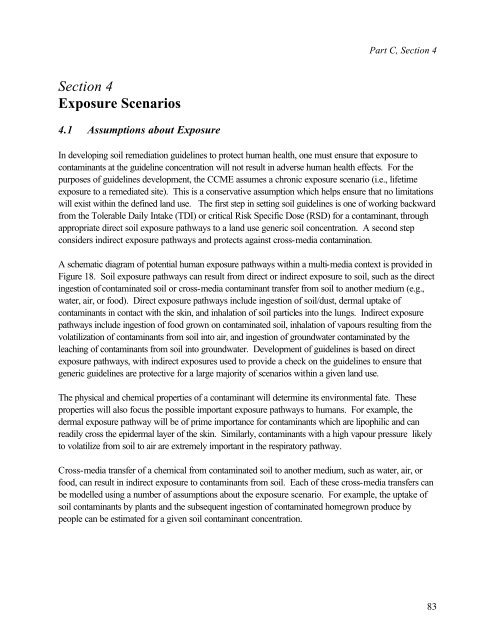Protocol for the Derivation of Environmental and Human ... - CCME
Protocol for the Derivation of Environmental and Human ... - CCME
Protocol for the Derivation of Environmental and Human ... - CCME
You also want an ePaper? Increase the reach of your titles
YUMPU automatically turns print PDFs into web optimized ePapers that Google loves.
Part C, Section 4<br />
Section 4<br />
Exposure Scenarios<br />
4.1 Assumptions about Exposure<br />
In developing soil remediation guidelines to protect human health, one must ensure that exposure to<br />
contaminants at <strong>the</strong> guideline concentration will not result in adverse human health effects. For <strong>the</strong><br />
purposes <strong>of</strong> guidelines development, <strong>the</strong> <strong>CCME</strong> assumes a chronic exposure scenario (i.e., lifetime<br />
exposure to a remediated site). This is a conservative assumption which helps ensure that no limitations<br />
will exist within <strong>the</strong> defined l<strong>and</strong> use. The first step in setting soil guidelines is one <strong>of</strong> working backward<br />
from <strong>the</strong> Tolerable Daily Intake (TDI) or critical Risk Specific Dose (RSD) <strong>for</strong> a contaminant, through<br />
appropriate direct soil exposure pathways to a l<strong>and</strong> use generic soil concentration. A second step<br />
considers indirect exposure pathways <strong>and</strong> protects against cross-media contamination.<br />
A schematic diagram <strong>of</strong> potential human exposure pathways within a multi-media context is provided in<br />
Figure 18. Soil exposure pathways can result from direct or indirect exposure to soil, such as <strong>the</strong> direct<br />
ingestion <strong>of</strong> contaminated soil or cross-media contaminant transfer from soil to ano<strong>the</strong>r medium (e.g.,<br />
water, air, or food). Direct exposure pathways include ingestion <strong>of</strong> soil/dust, dermal uptake <strong>of</strong><br />
contaminants in contact with <strong>the</strong> skin, <strong>and</strong> inhalation <strong>of</strong> soil particles into <strong>the</strong> lungs. Indirect exposure<br />
pathways include ingestion <strong>of</strong> food grown on contaminated soil, inhalation <strong>of</strong> vapours resulting from <strong>the</strong><br />
volatilization <strong>of</strong> contaminants from soil into air, <strong>and</strong> ingestion <strong>of</strong> groundwater contaminated by <strong>the</strong><br />
leaching <strong>of</strong> contaminants from soil into groundwater. Development <strong>of</strong> guidelines is based on direct<br />
exposure pathways, with indirect exposures used to provide a check on <strong>the</strong> guidelines to ensure that<br />
generic guidelines are protective <strong>for</strong> a large majority <strong>of</strong> scenarios within a given l<strong>and</strong> use.<br />
The physical <strong>and</strong> chemical properties <strong>of</strong> a contaminant will determine its environmental fate. These<br />
properties will also focus <strong>the</strong> possible important exposure pathways to humans. For example, <strong>the</strong><br />
dermal exposure pathway will be <strong>of</strong> prime importance <strong>for</strong> contaminants which are lipophilic <strong>and</strong> can<br />
readily cross <strong>the</strong> epidermal layer <strong>of</strong> <strong>the</strong> skin. Similarly, contaminants with a high vapour pressure likely<br />
to volatilize from soil to air are extremely important in <strong>the</strong> respiratory pathway.<br />
Cross-media transfer <strong>of</strong> a chemical from contaminated soil to ano<strong>the</strong>r medium, such as water, air, or<br />
food, can result in indirect exposure to contaminants from soil. Each <strong>of</strong> <strong>the</strong>se cross-media transfers can<br />
be modelled using a number <strong>of</strong> assumptions about <strong>the</strong> exposure scenario. For example, <strong>the</strong> uptake <strong>of</strong><br />
soil contaminants by plants <strong>and</strong> <strong>the</strong> subsequent ingestion <strong>of</strong> contaminated homegrown produce by<br />
people can be estimated <strong>for</strong> a given soil contaminant concentration.<br />
83
















